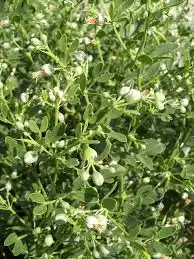Zygophyllum fabago, commonly known as Syrian Bean Caper, is a perennial shrub that belongs to the Zygophyllaceae family. This resilient plant is native to the Mediterranean region, thriving in arid and semi-arid climates.
The name Bean Caper is attributed to the plant’s association with capers, although it’s important to note that the two plants are distinct.
One of the notable features of Zygophyllum fabago is its adaptability to harsh environmental conditions. It often grows in rocky or sandy soils, making it well-suited to arid landscapes. The plant typically reaches a height of 1 to 1.5 meters and has greyish-green, pinnate leaves with small leaflets.
The flowers of Zygophyllum fabago are small, yellow, and star-shaped, creating a visually distinctive appearance. These flowers give way to fruit capsules that contain seeds.
The plant is known for its ability to reproduce both through seeds and vegetative means, contributing to its resilience in challenging habitats.
In terms of traditional uses, Zygophyllum fabago has been employed in folk medicine for various purposes. The plant is reported to have anti-inflammatory properties, and preparations made from its leaves and stems have been used to address conditions such as skin irritations and rheumatic pain.
However, it’s crucial to note that while there is a history of traditional use, scientific research on the medicinal properties of Zygophyllum fabago is limited, and caution should be exercised when considering it for therapeutic purposes.
The ecological significance of Zygophyllum fabago extends beyond its potential medicinal uses. The plant plays a role in stabilizing soil in arid environments and is well-adapted to withstand drought conditions. Its presence can contribute to biodiversity in these challenging ecosystems.
In some regions, Zygophyllum fabago is utilized as forage for livestock, as it can tolerate grazing pressure and provide a source of nutrition in arid landscapes where other vegetation may be scarce. However, it’s essential to manage grazing practices carefully to ensure the sustainable use of the plant.
As with any plant with reported medicinal properties, it is advisable to consult with healthcare professionals before using Zygophyllum fabago for therapeutic purposes.
Additionally, sustainable harvesting practices should be considered to preserve the plant’s populations and its ecological role in arid environments.
In summary, Zygophyllum fabago, or Syrian Bean Caper, is a hardy perennial shrub native to the Mediterranean region. Its adaptability to arid conditions, traditional uses in folk medicine, and ecological roles make it a noteworthy species in both natural ecosystems and human-inhabited landscapes.
Scientific exploration of its medicinal properties and sustainable management practices are crucial aspects of ensuring the responsible use and conservation of this plant.
The Botanical Description of Zygophyllum fabago
1. Morphology and Growth Habit: Zygophyllum fabago, commonly known as Syrian bean caper, is a perennial herb belonging to the Zygophyllaceae family. It typically reaches a height of 30 to 50 centimeters. The plant is characterized by a branching structure with slender stems, and it often forms dense mats due to its spreading nature.
2. Leaves and Stipules: The leaves of Zygophyllum fabago are small, elliptical, and arranged alternately along the stems. They are typically around 1 to 2 centimeters in length, with a waxy coating that gives them a glaucous appearance. Stipules, small leaf-like structures, are present at the base of each leaf.
3. Flowers and Inflorescence: The flowers of Zygophyllum fabago are distinctive and appear in clusters. Each flower has five petals, and the color varies from pale pink to white. The inflorescence is cymose, forming a branched structure that bears multiple flowers. Flowering usually occurs in late spring to early summer.
4. Fruits and Seeds: The plant produces capsule-like fruits that contain seeds. The capsules are about 1 to 1.5 centimeters in diameter and have a rounded shape. Upon maturity, they split open to release the seeds. The seeds are small, brown, and have a hard coat that aids in their dispersal.
5. Root System: Zygophyllum fabago has a well-developed root system that allows it to adapt to various soil conditions. The roots play a crucial role in anchoring the plant and absorbing nutrients from the soil.
The Geographic Distribution of Zygophyllum fabago
1. Native Range: Zygophyllum fabago is native to a wide geographic range, primarily found in regions of North Africa, the Middle East, and parts of Asia. Its natural habitat includes arid and semi-arid areas, and it is well-adapted to thrive in challenging environmental conditions.
2. Global Distribution: Due to its hardiness and adaptability, Zygophyllum fabago has been introduced to and naturalized in various parts of the world. It can now be found in parts of Europe, Australia, and North America. The plant often establishes itself in disturbed habitats, such as roadsides and abandoned fields.
3. Preferred Habitats: The plant exhibits a preference for well-drained soils and areas with abundant sunlight. It is commonly found in sandy, rocky, or gravelly soils, and its ability to tolerate drought makes it well-suited to arid landscapes.
4. Invasive Characteristics: In some regions, Zygophyllum fabago has displayed invasive tendencies, outcompeting native vegetation. Its adaptability to different soil types and climates contributes to its success as an invasive species in certain ecosystems.
5. Ecological Impact: The introduction of Zygophyllum fabago to new regions can have ecological implications, affecting the composition of plant communities and altering local ecosystems. Understanding its distribution patterns is crucial for managing its impact on biodiversity.
The Chemical Composition of Zygophyllum fabago
1. Phytochemicals: Zygophyllum fabago contains a variety of phytochemicals that contribute to its medicinal and biological properties. These include alkaloids, flavonoids, tannins, saponins, and terpenoids. The synergistic effects of these compounds give the plant its therapeutic potential.
2. Medicinal Components: Certain chemical constituents in Zygophyllum fabago have been studied for their potential medicinal benefits. Extracts from the plant have shown anti-inflammatory, antioxidant, and antimicrobial properties, suggesting its traditional use in herbal medicine may have a scientific basis.
3. Adaptogenic Compounds: The plant’s chemical composition includes adaptogenic compounds that enable it to withstand harsh environmental conditions. These compounds may also contribute to the plant’s resilience in traditional medicine applications.
4. Nutritional Value: While not a major food source, Zygophyllum fabago has been traditionally used for its nutritional value in some cultures. The plant contains vitamins, minerals, and antioxidants that contribute to its overall nutritional profile.
5. Potential Industrial Applications: Certain chemicals present in Zygophyllum fabago may have industrial applications. Research is ongoing to explore the potential use of extracts or compounds derived from the plant in various industries, including pharmaceuticals and cosmetics.
Read Also: 20 Medicinal Health Benefits Of Alstonia boonei (Scented Milkwood)
The Medicinal Health Benefits Of Zygophyllum fabago (Syrian Bean Caper)

1. Anti-Inflammatory Properties: Zygophyllum fabago has been traditionally recognized for its anti-inflammatory effects. Compounds found in the plant may help reduce inflammation, making it potentially beneficial for conditions involving inflammation, such as arthritis.
2. Antioxidant Activity: The plant exhibits antioxidant properties attributed to its phytochemical composition. Antioxidants help neutralize free radicals in the body, protecting cells from oxidative stress and contributing to overall health.
3. Wound Healing: Zygophyllum fabago has been used topically for wound healing. Its potential to accelerate the healing process and reduce infection may be attributed to certain bioactive compounds present in the plant.
4. Gastrointestinal Health: Traditional uses include the promotion of gastrointestinal health. Zygophyllum fabago may have mild laxative effects, aiding in digestion and relieving occasional constipation.
5. Respiratory Support: In some traditional practices, Zygophyllum fabago is employed for respiratory issues. Its potential bronchodilator properties may offer relief for respiratory conditions, although further research is needed.
6. Immune System Boost: Compounds in Zygophyllum fabago may contribute to immune system modulation. Regular consumption or usage of the plant may support immune function, helping the body defend against infections.
7. Diuretic Effects: Zygophyllum fabago has diuretic properties, promoting the increased excretion of urine. This may be beneficial for individuals looking to manage fluid retention and support kidney function.
8. Analgesic (Pain-Relieving) Effects: Traditional uses include the plant’s potential analgesic effects. It may help alleviate pain, making it a natural remedy for conditions associated with pain and discomfort.
9. Metabolic Support: Some traditional applications involve Zygophyllum fabago for metabolic support. It may play a role in promoting a healthy metabolism and supporting weight management.
10. Antimicrobial Potential: Studies suggest that Zygophyllum fabago possesses antimicrobial properties. This may contribute to its traditional use for combating infections and supporting overall microbial balance.
The Methods of Usage to Achieve the Provided Health Benefits Of Zygophyllum fabago (Syrian Bean Caper)
1. Herbal Infusions: One common method of utilizing Zygophyllum fabago is by preparing herbal infusions. Dried leaves or other plant parts can be steeped in hot water to create a medicinal tea.
2. Topical Applications: For wound healing and skin-related benefits, Zygophyllum fabago can be applied topically. Extracts or ointments made from the plant may aid in promoting skin health.
3. Capsule Supplements: In modern herbal medicine, Zygophyllum fabago may be available in capsule form. This provides a convenient way to incorporate the plant into a daily wellness routine.
4. Culinary Use: In some cultures, Zygophyllum fabago is used in culinary applications. It may be added to certain dishes, offering a way to enjoy its potential health benefits through food.
5. Smoking or Vaporizing: While not recommended due to potential side effects, in traditional practices, Zygophyllum fabago has been used by smoking or vaporizing the leaves for certain respiratory benefits.
6. Tinctures: Alcoholic tinctures can be prepared using Zygophyllum fabago. This method extracts the plant’s bioactive compounds and may offer an alternative to herbal infusions.
7. Culinary Seasoning: In regions where it is culturally accepted, Zygophyllum fabago may be used as a culinary seasoning. Its unique flavor adds depth to dishes while potentially providing health benefits.
The Side Effects Of Using Zygophyllum fabago Medicinal Plant
1. Allergic Reactions: Individuals with known allergies to plants in the Zygophyllaceae family may experience allergic reactions to Zygophyllum fabago. It is advisable to perform an allergy test before widespread use.
2. Gastrointestinal Discomfort: Excessive consumption of Zygophyllum fabago may lead to gastrointestinal discomfort, including nausea and diarrhea. Moderation is key to avoid these side effects.
3. Skin Sensitivity: Topical application may cause skin sensitivity in some individuals. It is recommended to perform a patch test before widespread use.
4. Respiratory Irritation: Smoking or vaporizing Zygophyllum fabago may lead to respiratory irritation. Caution is advised, and alternative methods of usage should be considered.
5. Potential Toxicity: In large quantities, certain compounds in Zygophyllum fabago may have toxic effects. Adhering to recommended dosages and usage methods is essential.
6. Interactions with Medications: Individuals taking medications should consult with healthcare professionals before using Zygophyllum fabago, as it may interact with certain medications.
7. Pregnancy and Breastfeeding: Pregnant and breastfeeding individuals should avoid Zygophyllum fabago, as its safety in these situations has not been established.
8. Central Nervous System Effects: Some traditional uses involve Zygophyllum fabago for psychoactive effects. However, excessive use may lead to undesirable central nervous system effects.
9. Cardiovascular Effects: Individuals with cardiovascular conditions should exercise caution, as Zygophyllum fabago may have cardiovascular effects.
10. Quality and Purity Concerns: When using Zygophyllum fabago products, ensuring the quality and purity of the source is crucial. Contaminants or adulterants can pose additional risks.
Read Also: The Ideal Instrument for Debeaking the Birds
The Scientific Research and Studies of Zornia latifolia

1. Anti-Inflammatory Properties: Numerous scientific studies have explored the anti-inflammatory potential of Zornia latifolia. Research suggests that the plant’s bioactive compounds may inhibit inflammatory pathways, making it a subject of interest for conditions involving inflammation.
2. Antioxidant Activity: Scientific investigations have delved into the antioxidant properties of Zornia latifolia. The presence of antioxidants may contribute to the plant’s ability to neutralize free radicals and protect cells from oxidative stress.
3. Analgesic Effects: Studies on the analgesic effects of Zornia latifolia have been conducted, indicating its potential as a natural pain-relieving agent. The mechanisms behind its analgesic properties are areas of ongoing research.
4. Anxiolytic and Stress-Reducing Properties: Some research suggests that Zornia latifolia may possess anxiolytic properties, potentially reducing stress and anxiety. Further studies are needed to understand the specific compounds responsible for these effects.
5. Respiratory Benefits: Scientific exploration into the respiratory benefits of Zornia latifolia has been undertaken. The bronchodilator effects of the plant may have implications for respiratory conditions, warranting further investigation.
6. Immunomodulatory Effects: The immunomodulatory potential of Zornia latifolia has been a subject of research. Understanding its impact on the immune system may shed light on its traditional uses for immune support.
7. Gastroprotective Properties: Some studies suggest that Zornia latifolia may have gastroprotective effects, possibly offering benefits for digestive health. Research in this area is still evolving.
8. Neuroprotective Effects: Preliminary studies hint at the neuroprotective effects of Zornia latifolia. Further research is needed to elucidate its potential role in supporting cognitive function and brain health.
The Safety Precautions and Recommendations In Using Zornia latifolia (“Mucuna Bracteata”) Medicinal Plant
1. Dosage Caution: While Zornia latifolia shows promise, it’s crucial to adhere to recommended dosages. Excessive consumption may lead to adverse effects, and individual tolerance varies.
2. Allergy Consideration: Individuals with known allergies to legumes or related plants should approach Zornia latifolia with caution. Allergic reactions, though rare, can occur.
3. Pregnancy and Breastfeeding: Due to limited research on the safety of Zornia latifolia during pregnancy and breastfeeding, it’s advisable for pregnant or nursing individuals to consult healthcare professionals before use.
4. Respiratory Risks: Smoking or inhaling Zornia latifolia is not recommended due to potential respiratory risks. The plant’s traditional use in smoking blends should be approached with caution.
5. Interactions with Medications: Individuals taking medications, especially those with sedative effects, should consult healthcare providers. Zornia latifolia may interact with certain medications.
6. Quality Assurance: Ensure the quality and purity of Zornia latifolia products. Contaminants or adulterants can pose risks, so sourcing from reputable suppliers is essential.
FAQs About Zornia latifolia (“Mucuna Bracteata”) Medicinal Plant
Q1: Can Zornia latifolia be used for children?
It’s advisable to consult with a pediatrician before giving Zornia latifolia to children. Dosage and safety considerations may differ for pediatric use.
Q2: Are there any contraindications with other medications?
Zornia latifolia may interact with certain medications, especially those with sedative effects. Consultation with healthcare professionals is recommended.
Q3: Can Zornia latifolia be used for chronic pain management?
While it shows potential for pain relief, individuals with chronic pain conditions should consult healthcare providers for a comprehensive pain management plan.
Q4: Is Zornia latifolia safe for long-term use?
Long-term use should be approached with caution. Regular monitoring and consultation with healthcare professionals can help assess safety over extended periods.
Q5: How can one ensure the quality of Zornia latifolia products?
Choose products from reputable suppliers, preferably those who adhere to quality standards. Third-party testing for purity can provide additional assurance.
Q6: Are there any reported cases of adverse effects from Zornia latifolia use?
While adverse effects are rare, individual reactions vary. It’s essential to start with small doses and monitor for any unexpected reactions.
Read Also: Comprehensive Fish Farming Guide

